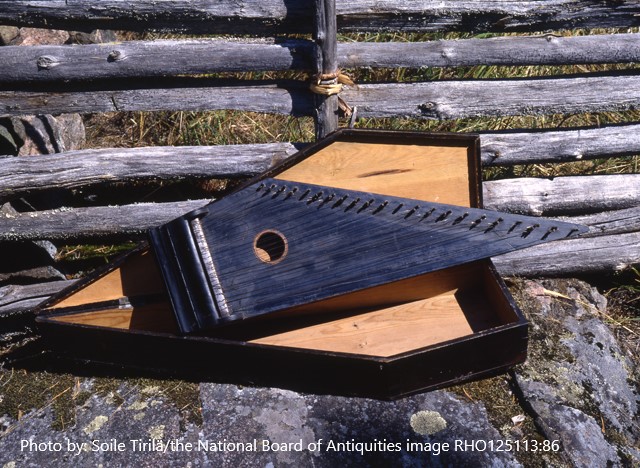On February 28, Finns celebrate the Kalevala Day. Kalevala is the national epic of Finland. In this blog post, we’ll discuss Kalevala and its’ compiler Elias Lönnrot.
National awakening
In our blog post for Runeberg’s Day in early February, we briefly discussed the national awakening of the 1800s.
We explained how in the early years of the 1800s, the Swedish-speaking intelligentsia of Finland brought the idea of nationalism to Finland. It increased interest in the Finnish language and in the culture of Finnish-speaking Finns.
For Runeberg, this interest showed in the topics he wrote about and how he wrote about them although he continued writing in Swedish. For others, it also meant studying Finnish and using the Finnish language in their literary works. Elias Lönnrot was one of them.
Elias Lönnrot
Lönnrot was born to a family of very modest means in what is now Lohja. The main image of this blog features his own kantele, a traditional plucked string instrument.
Lönnrot was able to go to school because others, including his older brother Henrik, recognized his abilities and helped him along. Several times during his school years, however, he had to quit school for a while and earn money to survive.


His interest in poetry and in the Finnish language started while he was working as a tutor in the manor house of Lauko. Although he did Bachelor’s degree in the humanities, his subsequent education and degrees were in medicine. He worked as a doctor until 1854 when he became the Professor of the Finnish language at the University of Helsinki.
While he worked as a doctor, he collected old Finnish poems in his several explorations over a number of years in central and northeastern Finland. During these trips, Lönnrot collected over 65 000 verses of folk poetry.
Lönnrot’s influence on the written Finnish language was enormous. He based his written Finnish on the western Finnish dialects but also infused it with eastern Finnish words. His influence is visible for example in legal and mathematical Finnish. He came up with Finnish language equivalents for such terms as, for example, fever (kuume), literature (kirjallisuus), nationality (kansallisuus), ink (muste), independent (itsenäinen), plural (monikko), right to vote (äänioikeus), etc.
In addition to being a doctor, folklorist, and linguist, Lönnrot was also a journalist. He wrote to several different newspapers and publications during his career. His own publication Mehiläinen (1836-1837, 1839-1840) was the first Finnish language periodical and only the fifth Finnish language newspaper.
Kalevala, the national epic of Finland
The best known of Lönnrot’s works in Kalevala, the national epic of Finland. There are two versions of it. The older Kalevala consists of 32 poems and about 12 000 verses. The newer Kalevala has about 22 800 verses divided into 50 poems. The latter edition is the one that students in Finnish schools still read.
We celebrate Kalevala Day on February 28 because that was the date in 1835 when Lönnrot signed the prologue to the old Kalevala.
The poems in Kalevala are not exact copies of the folk poems Lönnrot collected during his trips. Lönnrot edited, fixed, and rearranged verses. He believed that the folk poems he heard were based on historical events. Thus he tried to place poems on a coherent timeline. In doing so he edited them, combined verses from different poems, and even added his own verses. He stripped poems of what he considered Christian or modern elements and also sometimes changed the names of people and places.
Lönnrot didn’t place much emphasis on the individuals from whom he heard these poems. He thought the poems belonged to everybody. Based on his notes and letters, it is estimated that he collected poems from at least 70 different individuals.


The Language of Kalevala
The language of Kalevala is based on eastern dialects of Finnish as well as on dialects of the Carelian language. At times, Lönnrot edited the language so that it became more understandable to Finnish speakers.
The language that is in Kalevala has had an impact on modern Finnish. In the older version of Kalevala, there are at least 184 words that are now listed in the modern Finnish dictionary that weren’t in earlier Finnish dictionaries. There are also additional words that were known before but became widely used only after Kalevala was published.
Kalevala has also influenced Finnish names. These days there are, for example, plenty of Finnish first names that have their roots in Kalevala. Such names are, for example, Ilmari, Kyllikki, Aino, Terhi, Ilpo, Jouko, Kimmo, Sampo, Seppo, and Väinö. Most of these became popular already by the end of the 19th century and early 20th. Later, especially in the 1920s and 1930s, people started naming businesses, streets, and city districts with names from the Kalevala.


What’s in Kalevala
Kalevala takes place in the land of Kalevala, in Väinölä. That is where Väinämöinen and many of the other characters live. Pohjola is their enemy. Kalevala is beautiful and green. Pohjola is cold and inhospitable. There is also the land of animals and forest people, the land of the water, and the land of the deceased.
Väinämöinen, an old sorcerer, rules Kalevala. Väinämöinen practices his sorcery by singing and playing the kantele. The witch-like Louhi is the ruler of Pohjola, Tapio and Mielikki rule the forest, and Ahti and Vellamo the waters.
Kalevala is a story of the various battles between Väinölä and Pohjola. It is a story of betrayal, jealousy, revenge, greed, masculinity, feminity, and tensions between the old and the young. It starts with the story of how the world was created and ends with the birth of a baby boy and Väinämöinen leaving.
Kalevala and politics
Very early on Kalevala became the symbol of Finnish culture and Finnish history, the national epic of Finland. To the outside Finns were eager to emphasize that a people so small and poor had an epic of its own. An epic, that held its own against classical Greek literature.
Internally, different political factions within Finland have argued over the ownership of Kalevala: Who does Kalevala belong to and whose interpretation of it is more accurate?
In Finland today, references to Kalevala are sometimes used to prove one’s knowledge of and ties to Finnish culture and history. If a speaker wants to define something as old and quintessentially Finnish, he/she can turn the word Kalevala into an adjective kalevalainen. Anything that is kalevalainen is somehow seen to embody and reflect some fundamental and historical Finnishness.
Kalevala in art
Kalevala has inspired Finnish painters, composers, architects, and other artists throughout the years.
There are the Kullervo symphony and Lemminkäinen series of Jean Sibelius, Kalevala themed paintings by Akseli Gallén-Kallela, and Kalevala themed operas by Einojuhani Rautavaara. Elias Lönnrot’s Kalevala has also influenced other writers such as Eino Leino. Kalevala has also inspired several Finnish choreographers.


Kalevala has appeared in tv as an animated series and as a tv miniseries, and on the silver screen as a joint Soviet-Finnish production.
Translations of Kalevala
Kalevala has been translated to several languages from Arabic to Vietnamese and everything in between.
Some of these translations are quite old, but there are quite recent translations in most of the European languages at least. If you would like to read Kalevala in your native language, check the collections of the University of Helsinki Library. They have copies in several languages as does the Helsinki City Library. If your city library doesn’t have a copy in your native language, try to get one through an interlibrary loan from Helsinki.


Get the “Your Crash Course to Finland” online course – your gateway to all things Finnish – now from our online store.
The mission of Finnwards is to help internationals thrive in their life abroad. We provide coaching, consulting, and training services that help them do just that. Check out our Services for Businesses and Organizations or our Expat Inspiration Catalog for more information! While we serve internationals and their employers all over the world, our specialty is Finland. With our help, internationals can build a uniquely Finnish life for themselves and their family. In addition to the coaching, consulting and training services, we also offer a wide selection of self-guided online courses about Finland. Contact us and let us help you or your employees succeed in their professional and private lives abroad and in Finland.
- Most common jobs for foreigners in Finland - August 29, 2024
- Skills recognition and learning at work in Finland - April 18, 2024
- It pays off to study – a glance at expected career lengths in Finland - April 4, 2024




